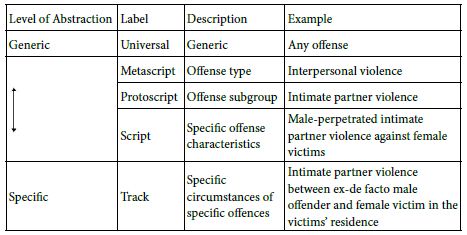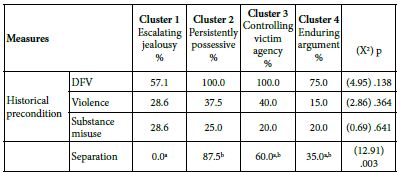The endemic nature of intimate partner violence continues to pose a significant challenge to government policy makers and those on the frontline charged with responding to calls for help. Whilst not a panacea, innovative approaches may help reduce the burden of intimate partner violence. The study by Christine Carney, Mark Kebbell, Li Eriksson and Regan Carr, titled “Different Scripts, Different Casts: A Crime Script Analysis Indicating Intimate Partner Violence is not all the Same,” used a novel approach to understanding intimate partner violence reported to police [1].
Theoretical Framework
Crime script analysis tells the story of how a crime is committed from the initial decision of the offender to act through to exiting the scene of the crime and disposing of the evidence [2] Differing levels of analysis can be used ranging from the generic to the specific (Table 1).
Crime script analysis has been used to understand violent crimes such as sex crimes but the utility of this approach has rarely been used to explore intimate partner violence [3,4].
Table 1: Crime Script Levels of Analysis

Methodology and Key Findings
Qualitative thematic analysis of police administrative data was used to develop a Protoscript of intimate partner violence. This Protoscript identified commonality across offender criminal histories and recent situational factors identified in the extant literature as precursors to high risk and/or lethality . These factors included a history of violence, recent substance use, recent or pending separation and ongoing relationship issues. The location of contact between offender–victim, precursors to escalation (such as an escalating argument and accusations of infidelity immediately prior to violence), followed by the actions of the offender and victim were also captured (Figure 1) [5,6].

Figure 1: Intimate Partner Violence Protoscript
Cluster analysis was then used to identify distinct script tracks from the data, with Bonferroni’s Post-Hoc Test to determine statistically significant differences between the clusters. The analysis identified four distinct script tracks of intimate partner violence, ‘Escalating Jealousy’, ‘Persistently Possessive’, ‘Controlling Victim Agency’, and ‘Enduring Argument’ (Table 2).
Table 2: Cluster Analysis – Script Tracks


Note. Each superscript letter (e.g., a) indicates a subset of group categories (i.e., clusters) whose proportions do not differ from one another at the .05 significance level. Percentages that are not statistically different share superscript letters, while percentages that are statistically different do not share superscript letters.
Conclusion and Policy Implications
The clusters identified in this study found that half of all intimate partner violence incidents were associated with ongoing or escalating arguments as opposed to jealous or controlling behaviors – an important distinction given prior research has shown that jealousy and controlling behaviors are high risk factors for future harm and lethality. This suggests that of all incidents attended by police, it is likely that 50% of incidents involve potentially high risk factors that must be identified and effectively addressed. For incidents such as those within the persistently possessive cluster, where several high risk factors including history of control, jealousy, separation, and ongoing jealous, controlling, and stalking behaviors are evident, more punitive responses may be required. The remainder of incidents that do not display controlling behaviors may require a different response, such as support to referral services, anger management, financial support or other more generalist support options [7].
Understanding diversity within intimate partner violence may support policy and procedural changes designed to better identify specific behaviors evident within incidents that police attend. It could also provide guidance on the most appropriate action to take at the scene and following an intimate partner violence incident.
References
- Carney, CT, Kebbell, MR, Eriksson, L, Carr RM (2023) Different Scripts, Different Casts: A Crime Script Analysis Indicating Intimate Partner Violence Is Not All the Same. Violence Against Women, 30(9).
- Cornish D (1994a) Crimes as scripts. proceedings of the International Seminar on Environmental Criminology and crime analysis, University of Miami Coral Gables, Florida.
- Beauregard, E, Rossmo, DK, Proulx J (2007) A Descriptive Model of the Hunting Process of Serial Sex Offenders: A Rational Choice Perspective. Journal of Family Violence, Benoit Leclerc, S. a. R. W (2014) Interpersonal scripts and victim reaction in child sexual abuse.
- A quantitative analysis of the offender–victim In R. Wortley, B. Leclerc (Eds.), Cognition and Crime: Offender decision making and script analyses. Routledge.
- Boxall, H, Boyd, C, Dowling, C, Morgan A (2018) Understanding domestic violence incidents using crime script analysis. Trends and Issues in Crime and Criminal Justice, Available from: https://www.aic.gov.au/sites/default/files/2020-05/ pdf
- Stark E (2007) Coercive control: How men entrap women in personal life. Oxford University Press.
- Johnson, H, Eriksson, L, Mazerolle, P, Wortley R (2019) Intimate Femicide: The Role of Coercive Feminist Criminology, 14(1),Availabel From: https://doi. org/10.1177/1557085117701574
- Ibid, Myhill, A, Hohl K (2019) The “Golden Thread”: Coercive Control and Risk Assessment for Domestic Violence. Journal of interpersonal violence, 34(21-22) Available From: https://doi.org/10.1177/0886260516675464